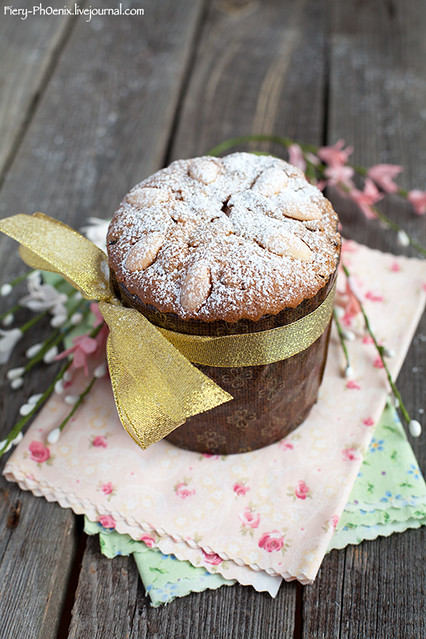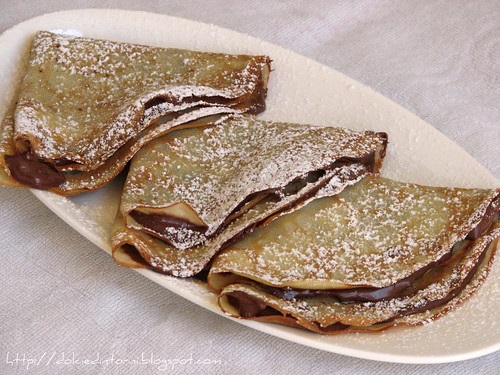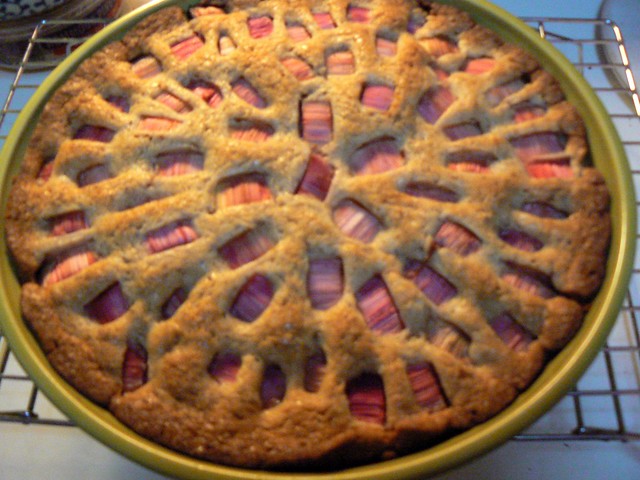2,2 lb flour
2 1/2 cup milk
2 oz yeast
5 ea eggs
7 oz sugar
10 oz butter
7 oz peeled almonds
1 ea lemon
5 oz raisins
salt to taste
Method:
Bring milk to boil and cool down. Dissolve yeast in a part of milk, add 1 tb sugar. Stir in flour in the rest of milk, add yeast and mix thoroughly. Cover with towel and put in a warm place. Kulich dough must be "coddled" and "cherished", the temperature of the dough must not less than 29-30C. Beat up 5 yolks with the rest of sugar. Melt butter, chop finely a lemon and a half of almonds. Add yolks, melted butter, chopped almonds and lemon, raisins, salt to the risen up dough. At the end stir in beaten to a white foam egg-whites. Knead the dough carefully upside down. Grease the mold for Kulich with soft butter, sprinkle with flour and pour in the dough half. Leave in a room to rise. When the dough is up to the top, brush the top with yolk and sprinkle with almonds. Bake in the oven 180 C. The duration of baking depends on the size of Kulich and can last 1-2 hours.
Recipe from ruscuisine.com
Photo from https://www.flickr.com/photos/fiery-phoenix/8354790034/

Cake Napoleon is also a traditional baked good. It is really yummy but it is difficult to make and may not always work out first time. The recipe follows below and is from ruscuisine.com. Photo from
http://godfulfood.blogspot.ie/2010/01/for-cakes-sake.html
1 lb flour
1/2 lb butter
1 ea egg
1 tbsp vinegar
Icing:
1 sugar
1/2 qrt milk
2 ea eggs
2 tbsp flour
1/2 lb butter
vanilla
Method:
Icing: Mix sugar, eggs, flour and then pour over milk. Cook on low heat, stirring regularly, until dense. When icing cools down a little, add butter and vanilla. Dough: cut margarine into small pieces and toss with flour until smooth. Mix egg, vinegar in 1 cup of water and add it to flour. Knead the dough until elastic and smooth. Divide the dough into 8 parts and put in the fridge for 40-60 minutes. Roll out every part very thin, put in a baking form, cut out remains, pierce with a fork and bake in a preheated oven until light golden. Bake the remains of dough until golden colour. Spread the icing on every shortcake and on the top. Crumb the dough remains and sprinkle all the cake with them. Puy in a fridge at least for a couple of hours.

Russain Bliny is also very commonly eatren in Russia. It is a simple but delicious recipe and is eaten all year round. It is very similar to a pancake but it contains yeast and butter.
1 lb flour
2 tbsp sugar
4 c milk
1 tsp salt
3 tbsp butter
6 tbsp yeast
2 ea eggs
Method:
Dissolve the yeast in 2 c of warm water and adding 500 g flour. Mix until smooth, cover with a cloth and set aside in a warm place for about an hour, or until the batter becomes bubbly. Add salt, sugar, egg yolks, melted butter and mix thoroughly. Add the rest of the flour gradually and beat up until smooth. Pour in warm milk gradually, and mix the batter thoroughly. Cover with a cloth and set aside in a warm place to rise. After the batter rises, beat until it is settled and then stir in beaten egg whites. The batter should rise no less than 3 times. As soon as the batter rises, cook the pancakes on a hot griddle.
Recipe from ruscuisine.com
Photo from http://russianclub.wikidot.com/bliny




